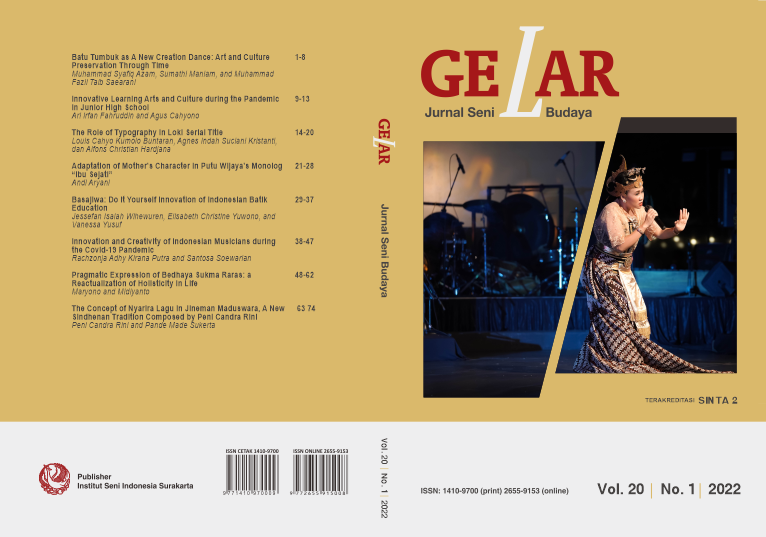Basajiwa: Do It Yourself Innovation of Indonesian Batik Education
Main Article Content
Abstract
Downloads
Article Details
Copyright
Authors who publish with Gelar: Jurnal Seni Budaya agrees to the following terms:
- Authors retain copyright and grant the journal right of first publication with the work simultaneously licensed under a Creative Commons Attribution License (CC BY-SA 4.0) that allows others to share the work with an acknowledgment of the work's authorship and initial publication in this journal.
- Authors are able to enter into separate, additional contractual arrangements for the non-exclusive distribution of the journal's published version of the work (e.g., post it to an institutional repository or publish it in a book), with an acknowledgment of its initial publication in this journal.
- Authors are permitted and encouraged to post their work online (e.g., in institutional repositories or on their website) prior to and during the submission process, as it can lead to productive exchanges, as well as earlier and greater citation of published work.
References
Elmiani, Haqu I. 2021. “Motivasi Milenial pada Penggunaan Outfit Batik,” (Studi Pada Mahasiswa Fakultas Ekonomi dan Bisnis Universitas Brawijaya. Brawijaya Knowledge Garden. http://repository.ub.ac.id/183048/.
Fajri, Dwi L. 2021. “Pengertian Self Healing dan Cara Melakukannya - Lifestyle Katadata.co.id.” Katadata. https://katadata.co.id/safrezi/berita/6197460447a80/pengertian-self-healing-dan-cara-melakukannya.
Fundrika, Bimo A. 2021. “Butuh Keterlibatan Anak Muda Agar Batik Tetap Lestari.” Suara.com. https://www.suara.com/lifestyle/2021/10/02/134500/butuh-keterlibatan-anak-muda-agar-batik-tetap-lestari?page=all.
Hasan, Renta V. 2012. “Studi Komparasi Motif Batik Parang Rusak Barong Gaya Yogyakarta dan Gaya Surakarta.” Literasi: Jurnal Ilmu-Ilmu Humaniora 2, no. 1 (Juni): 71-79. http://repository.unej.ac.id/bitstream/handle/123456789/58515/publikasi%20jurnal_renta.pdf?sequence=1&isAllowed=y.
“Indonesian Batik - intangible heritage - Culture Sector - UNESCO.” n.d. Intangible Cultural Heritage. Accessed March 6, 2022. https://ich.unesco.org/en/RL/indonesian-batik-00170.
“Indonesian Batik - intangible heritage - Culture Sector - UNESCO.” n.d. Intangible Cultural Heritage. Accessed 9 27, 2021. https://ich.unesco.org/en/RL/indonesian-batik-00170.
Joachimsthaler, Erich, and David A. Aaker. 2002. Brand Leadership. N.p.: Simon & Schuster.
Kerlogue, Fiona. 2004. The Book of Batik. Edited by Rudolf G. Smend. N.p.: Archipelago Press.
Munasya. 2017. “Apa dan Siapa itu Generasi Muda.” Coretan dari Desa. https://munasya.com/apa-dan-siapa-itu-generasi-muda/.
Nasir, Moh. 1998. Metode penelitian. N.p.: Ghalia Indonesia.
Paguyuban Pecinta Batik Indonesia Sekar Jagad. 2015. Batik Indonesia: Mahakarya Penuh Pesona. Jakarta: Kakilangit Kencana.
Permata, Rika R., Tasya S. Ramil, and Biondy Utama. 2019. “Pentingnya Merek bagi Pelaku Usaha Mikro, Kecil, dan Menengah di Jawa Barat.” Dialogia Iuridica 10, no. 2 (04): 34-39. https://doi.org/10.28932/di.v10i2.1133.
Priharto, Sugi. 2020. “Analisis SWOT: Pengertian, Metode Analisis, dan Contohnya.” CPSSOFT. https://cpssoft.com/blog/bisnis/pengertian-analisis-swot/.
Priskila, Trisia. 2018. “Pengaruh Persepsi Generasi Langgas Tentang Kualitas dan Inovasi Batik Terhadap Keputusan pembelian di Era Digital.” Journal of Business and Applied Management 11 (1): 25-37. https://journal.ubm.ac.id/index.php/business-applied-management/article/download/1071/940.
Ramadhan, Iwet. 2013. Cerita batik. Edited by Siti N. Andini. N.p.: Literati.
Ramelan, Tumbu. 2010. Batik Masterpieces. N.p.: KR Communications.
Sejuta, Agung. 2016. “Pengertian Penelitian Deskriptif Kualitatif, Mahasiswa Skripsi Wajib Tahu.” Linguistik Id. https://www.linguistikid.com/2016/09/pengertian-penelitian-deskriptif-kualitatif.html.
Situngkir, Hokky. 2020. “The Phylomemetics of Batik.” SSRN. https://papers.ssrn.com/sol3/papers.cfm?abstract_id=1481394.
Suliyanto, Weni Novandari, and Sri M. Setyawati. 2016. “Persepsi Generasi Muda Terhadap Profesi Pengrajin Batik Tulis di Purbalingga.” Jurnal Ekonomi dan Bisnis 18, no. 1 (6): 135-144. DOI: https://doi.org/10.24914/jeb.v18i1.275.
Sumarsono, Hartono. 2019. Batik sudagaran Surakarta: koleksi Hartono Sumarsono. N.p.: PT Gramedia Pustaka Utama.
“UU Kepemudaan.” n.d. Peraturan.go.id. Accessed March 9, 2022. https://peraturan.go.id/common/dokumen/ln/2009/uu40-2009.pdf.
Wibisono, Anton. 2019. “Memahami Metode Penelitian Kualitatif.” Direktorat Jenderal Kekayaan Negara. https://www.djkn.kemenkeu.go.id/artikel/baca/12773/Memahami-Metode-Penelitian-Kualitatif.html.
Wolf, Marco, and Shaun McQuitty. 2011. “Understanding The Do-It-Yourself Consumer: DIY Motivations and Outcomes.” AMS Rev 1 (12): 154-170. 10.1007/s13162-011-0021-2.
